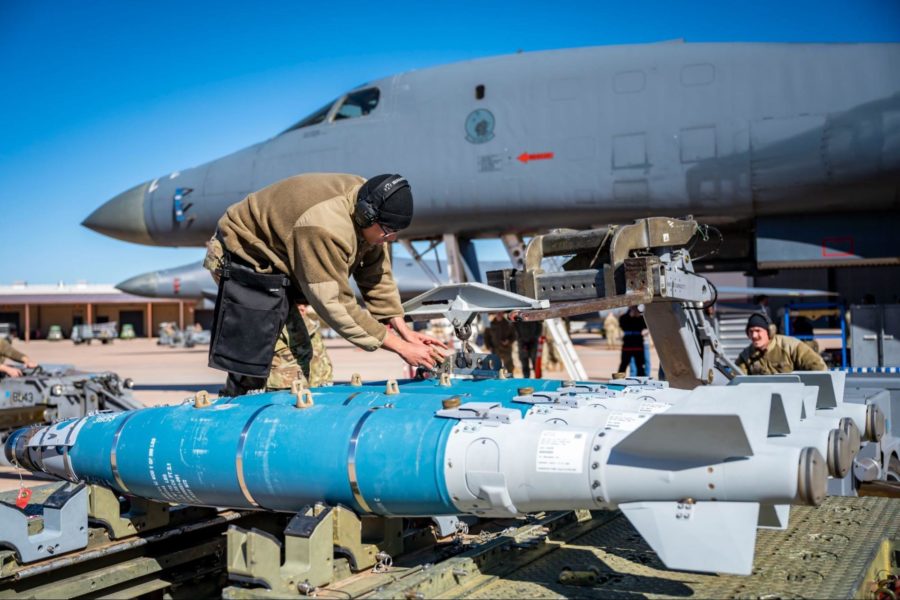The Air Force wants its suppliers to make weapons faster—and it may have to accept less efficiency as the price of the surge production capacity needed for a modern fight, Chief of Staff Gen. Charles Q. Brown, Jr. said Feb. 13.
The service is analyzing the weapon stockpile levels it requires for modern conflicts, looking for a balance between inexpensive, less-sophisticated munitions and high-end weapons, Brown said during a talk hosted by the Brookings Institution.
The service is doing “deeper dives on these [issues] to take a really hard look at where we are, from a munitions standpoint,” Brown said.
Over the years, Brown noted, weapons purchases have been structured to be “very efficient,” but “in some cases, to be able to move forward, we have to probably be less efficient.”
Brown’s remarks echo comments from Pentagon acquisition and sustainment chief William LaPlante and other defense leaders who have said the U.S. military must shift from “just-in-time” weapons production—which is efficient but geared for peacetime consumption—to a Cold War-style footing wherein munitions manufacturers have extra capacity in order to surge production for wartime usage.
This is less efficient, but the rapid drawdown of U.S. munitions being provided to Ukraine has highlighted the lack of depth in U.S. weapons production capacity and raised alarm on Capitol Hill that manufacturing is out of synch with world events.
Brown said the Air Force needs to keep in mind the experience of World War II, in which the supply of goods was critical to victory. “COVID taught us a few things about supply chains,” he noted.
However, “we’re also in a different place because of technology, where you’re able to do … digital engineering … and modular capabilities, to be able to do things a bit faster,” Brown added, referring to Air Force initiatives to rapidly design new weapons with modular features, allowing a mix-and-match capability to configure weapons with different seekers, warheads and propulsion systems.
Making munitions modular and with an open-systems architecture can potentially speed up design and production. The Air Force has issued several requests for information to industry to offer ideas on implementing such ideas.
“I’ve … had a chance to visit some of our industry partners to see how they’re … looking at automation and the ability to build weapons a bit faster than we have in the past,” Brown said.
While Air Force inventories are “in a decent spot,” Brown said he won’t be satisfied with mere sufficiency.
“I want to make sure we have an overwhelming advantage,” he said.
The Air Force is looking for “that balance” between “highly capable weapons that are very expensive, but you may not have that capacity,” and the less-costly, level-of-effort weapons to prosecute a long-term campaign, Brown said.
Analysts have predicted a war with China over Taiwan could require hitting upwards of 50,000 targets, and a high tempo of airstrikes could empty munitions bins in less than two weeks.
The Air Force also needs its Joint All-Domain Command and Control system to be functional, so that it can make the best use of the munitions it has, Brown said.
The JADC2 element is critical, as hitting “moving targets at scale is really important.” Brown said there’s a danger of a mismatch, in which “you can have a bunch of targets [with] no munitions, or a bunch of munitions and no targets because you can’t move the information.”
Air Force Secretary Frank Kendall has supplemented his seven “operational imperatives” with task forces to study future requirements in three “cross-cutting” operational areas that underlie all other activities: munitions, airlift, and electronic warfare.
The Weapons Functional Integration Team is co-chaired by Brig. Gen. Jason Bartolomei, the program executive officer for weapons and head of USAF’s armament directorate, and Col. Christopher Buckley, chief of weapons development and requirements in the Air Force Futures shop.
Each of the cross-cutting teams is co-led by an acquirer and an operator in order to ensure that what USAF buys is operationally suitable and arrives within a relevant timeframe. The teams also have heavy input from industry, who provide context on what is realistically possible.
Each of the cross-cutting teams is also developing a roadmap of their focus areas, charting the planned deployment of new capabilities and the sunsetting of old ones no longer deemed credible or relevant. The weapons team is building its roadmap, which is classified.
Bartolomei told Air & Space Forces Magazine in a January interview that the roadmap is iterative and continually updated, but that an early version informed the fiscal year 2024 defense budget request.
